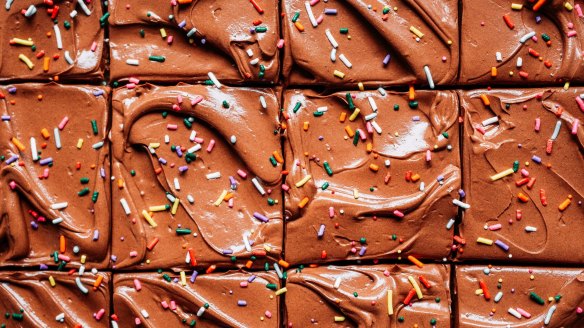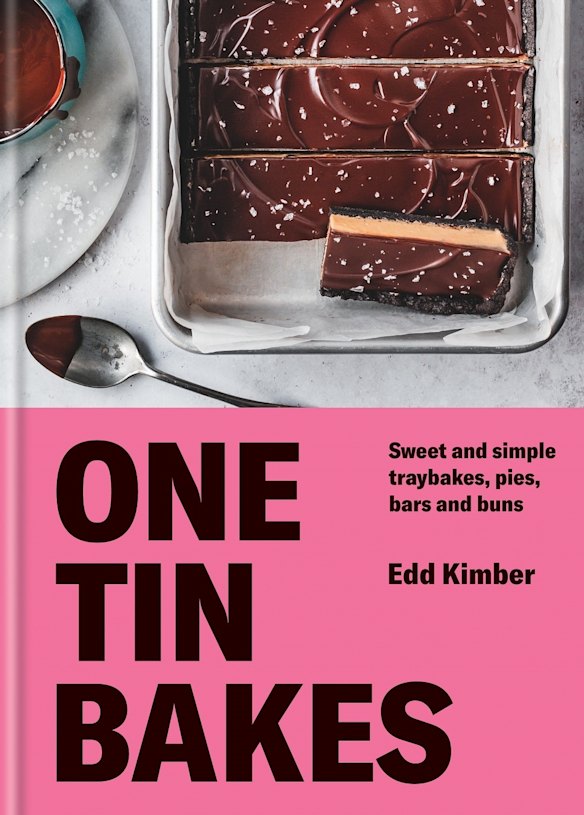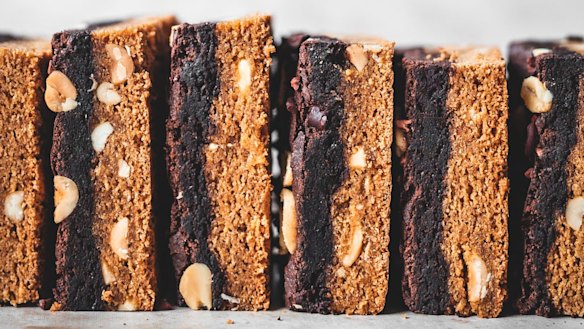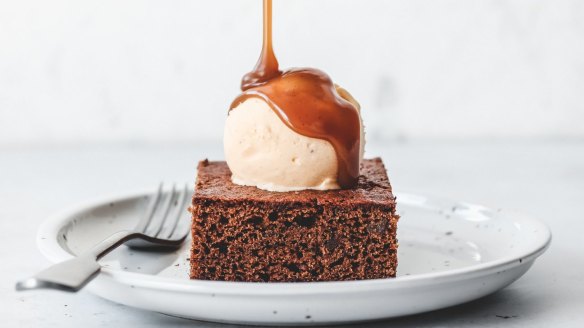Three sweet and simple treats to bake in a brownie tin

Don't own every baking vessel known to man? That's OK. If you have a brownie tin and a few basic ingredients, you'll be able to make pretty much anything in British baker and food writer Edd Kimber's new cookbook, One Tin Bakes.
It shares 70 recipes, including cakes, cookies and brownies, desserts and even bread – every one cooked in a single 23cm x 33cm brownie tin (note: manufacturers measure this slightly differently, some are a little wider, some a little shorter, but so long as your tin is at least 5cm deep, these recipes will fit without any issues).
Why this tin? Why not a round cake tin or a loaf pan? Kimber believes this tin is the most flexible, useful tin there is – it's a mainstay of any baker's arsenal and if you bake there is a good chance you already own one. If not, you'll find them in every cookware shop going.

Classic birthday cake
It's the law, birthday cake needs to include both chocolate and sprinkles, lots of sprinkles. When I was little, the birthday cake of choice was a simple cocoa affair topped with melted milk chocolate and decorations made from Smarties, chocolate fingers and any other candy desired that year. This recipe feels like another of those classic cakes, a simple yellow cake base and a chocolate fudge frosting. As this is not a layer cake, the fudge frosting doesn't need to be thick enough to hold a second cake layer. It's silky and smooth and stays that way, it won't harden over time.
INGREDIENTS
For the sheet cake
- 170g unsalted butter, at room temperature, plus extra for greasing
- 320g plain flour
- 3 tsp baking powder
- ½ tsp fine sea salt
- 350g castor sugar
- 3 large eggs
- 2 tsp vanilla extract
- 175ml sour cream
For the chocolate fudge frosting
- 340g unsalted butter, at room temperature
- 120g icing (powdered) sugar
- 2 tbsp golden syrup or clear honey
- 60g cocoa powder
- 80ml hot water
- 80ml sour cream
- 1 tsp vanilla extract
- 200g dark chocolate (70 per cent cocoa solids), melted and cooled
- sprinkles of your choice, to decorate
METHOD
- Preheat the oven to 160C fan-forced (180C conventional). Lightly grease the baking tin and line the base with a piece of baking paper.
- For the cake, place the flour, baking powder and salt into a large bowl and whisk briefly to combine. Add the butter and sugar to a separate large bowl and, using an electric mixer, beat together on medium-high speed for about 5 minutes until light and fluffy. Add the eggs, one at a time, beating until fully combined before adding another. Add the vanilla and mix briefly to combine. Scrape the batter into the prepared tin and level out. Add the flour mixture in three additions, alternating with the sour cream, starting and finishing with the flour.
- Bake for 35-40 minutes or until the cake springs back to a light touch. Leave to cool in the tin.
- For the fudge frosting, place the butter in a large bowl and use an electric mixer to beat on high speed for a couple of minutes or until creamy and smooth. Add the sugar, golden syrup (or honey) and cocoa powder and beat on high speed for 5 minutes or until light and fluffy. Add the hot water, sour cream and vanilla to a small jug and whisk together. Add the sour cream mixture to the bowl and mix on medium speed until combined. It will look separated for a while but will come back together as a smooth frosting. Add the melted chocolate and beat briefly until smooth and silky.
- Spread the frosting over the cake, finishing with a generous amount of sprinkles, which as far as I am concerned are mandatory. Cut into squares to serve. Store in a sealed container for up to 3 days.
Serves 12-16

Peanut butter brookies
What's better than a brownie? A brownie with a layer of peanut butter cookie, that's what. While you are technically making two recipes for just one dish, both are quick and easy and, trust me, these brownies are worth the little extra effort. The beauty of this dish (other than its flavours) is the textures, as the brownie is tender and fudgy, packed full of rich chocolate flavour, while the cookie is chewy and just a little bit salty from the peanuts, which really helps amp up the peanut flavour. As there is so much going on in this, I prefer to cut it into smaller pieces, 24 pieces per recipe, but you can serve these as normal brownies, so 12 pieces per recipe.
INGREDIENTS
For the peanut butter cookie layer
- 160g smooth peanut butter
- 220g light brown sugar
- 1 large egg, plus 2 large egg yolks
- 100g plain flour
- 1 tsp bicarbonate of soda
- ½ tsp fine sea salt
- 100g salted peanuts, roughly chopped
For the brownie layer
- 150g unsalted butter, diced, plus extra for greasing
- 85g cocoa powder
- 100g castor sugar
- 100g light brown sugar
- ¼ tsp fine sea salt
- 1 tsp vanilla extract
- 2 large eggs
- 70g plain flour
METHOD
- Preheat the oven to 160C fan-forced (180C conventional). Lightly grease the baking tin and line with a piece of baking paper that overhangs the two long sides. Secure in place with metal clips. For the peanut butter cookie layer, mix the peanut butter and brown sugar together in a large bowl for a couple of minutes until combined and slightly lightened. Add the egg and egg yolks and beat together for a further 2-3 minutes. Add all the remaining ingredients (reserving 3 tablespoons of the peanuts for sprinkling over later) and gently mix together to form a uniform cookie dough.
- Spread the cookie dough in an even layer in the prepared tin, then set aside.
- For the brownie layer, add the butter and cocoa to a small saucepan over a medium heat, stirring constantly, until melted and smooth. Remove from the heat and set aside. Place the sugars, salt, vanilla and eggs in a large bowl and whisk together with an electric mixer for 2-3 minutes or until slightly thickened and pale. Pour in the melted butter mixture, mixing briefly until combined, then fold in the flour. Pour the batter over the cookie layer and spread into an even layer, then sprinkle over the reserved peanuts.
- Bake for about 25-30 minutes, or until a skewer inserted into the middle comes out with a few moist crumbs.
- Leave the brookies to cool completely in the tin, before using the parchment paper to lift them from the tin and cutting into squares. Store in a sealed container for 3-4 days.
Makes 12-24, depending on desired size

Sticky date pudding with rum butterscotch sauce
If there is one dessert that I'm almost guaranteed to order if I spot it on a menu, it's a sticky toffee pudding. Surely there is nothing better on a cold winter's night than a warming, spiced and sticky date pudding with plenty of rich butterscotch sauce and either cream or, my personal favourite, vanilla ice-cream?
INGREDIENTS
For the sticky date pudding
- 120g unsalted butter, at room temperature, plus extra for greasing
- 250g self-raising flour
- 3 tsp ground cinnamon
- 3 tsp ground ginger
- 1½ tsp fine sea salt
- 250g pitted dried Medjool dates*, diced
- 1½ tsp bicarbonate of soda (baking soda)
- 85g golden syrup
- 220g light brown sugar
- 1 tsp vanilla extract
- 3 large eggs
For the butterscotch sauce
- 85g unsalted butter
- 150g light brown sugar
- 60ml dark rum
- ½ teaspoon flaked sea salt
- 1 teaspoon vanilla extract
- 120ml double (heavy) cream
- vanilla ice-cream, to serve
METHOD
- Preheat the oven to 160C fan-forced (180C conventional). Lightly grease the baking tin, then line with a large piece of baking paper so that the excess goes up the sides.
- For the pudding, mix the flour, spices and salt in a large bowl and set aside. Place the dates into a medium saucepan and pour over 240ml water. Bring to a simmer, then cook gently until almost all of the water has evaporated or been absorbed and the dates have softened. Remove from the heat and mix through the bicarbonate of soda.
- Place the butter, golden syrup and sugar into a separate large bowl and beat together until light and fluffy using an electric mixer. Beat in the vanilla, then the eggs, one at a time, beating until fully combined before adding another. Fold in the flour mixture until just combined. Scrape the date mixture into the bowl and stir to combine, then scrape into the prepared tin and spread into an even layer.
- Bake for 30-35 minutes, or until the pudding springs back to a light touch.
- Meanwhile, make the butterscotch sauce. Place the butter and sugar into a medium saucepan and cook over a medium heat until melted and bubbling. Cook for a further 2-3 minutes, to deepen the flavour. Add the rum and cook for 30 seconds, then stir in the salt, vanilla and cream and simmer for a further 3-5 minutes to make a thick but pourable sauce.
- Set aside until needed.
- Leave the pudding to cool for a few minutes before serving warm, topped with the warm butterscotch sauce and a large scoop of vanilla ice-cream.
Serves 10-12
Note: This pudding is best served on the day it's made, but store any leftovers in a sealed container for 3 days and gently reheat the pudding in the oven before serving.
*Any type of dried dates will work, but Medjool dates tend to have the best flavour.
This is an edited extract from One Tin Bakes by Edd Kimber, Hachette Australia, RRP $32.99. Photography by Edd Kimber. Buy now